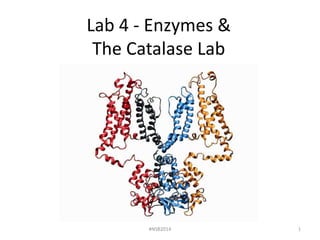
Lab 4 enzymes and the catalase lab fall 2014
- 1. Lab 4 - Enzymes & The Catalase Lab #NSB2014 1
- 2. After completing this activity, students will be able to: • Determine the household use of Hydrogen Peroxide • Recognize different enzymes and their characteristics • Compare and contrast the catalase in animal vs. plant cells • Explain why temperature and pH would have an effect on enzyme activity #NSB2014 2
- 3. What are Enzymes? • Enzymes are Biological Catalysts - substances that increase the speed of chemical reactions. • When an enzyme is present it takes less energy to start a chemical reaction (activation energy) • Enzymes help maintain homeostasis • Enzymes facilitate metabolism – which is essential for life #NSB2014 3
- 4. • Enzymes are proteins. • Proteins are made up of amino acids • Enzymes work with a very specific substrate (the molecule acted on by an enzyme) to speed up a reaction #NSB2014 4
- 5. • Enzymes have one or more deep folds on its surface • These folds form pockets called active sites • Enzymes act on the substrate, by fitting into the active site like a puzzle #NSB2014 5
- 6. Enzymes and their substrates • Each enzyme has a definite 3-D shape that allows it to bind with its substrate • Each enzymes acts only on one specific substrate, which means they break down specific substances (like a lock and key) #NSB2014 6
- 7. Why do we need enzymes? • Enzymes work to: – Turn leaves colors in the fall (think of the yellows, oranges, reds, purples) – Ripen foods (this is what makes your bananas brown, or apples get mushy), – Digest foods after they are eaten, – Produce DNA and hormones • Without enzymes, life as we know it is not possible #NSB2014 7
- 8. What affects enzymes in a reaction? • Temperature • pH #NSB2014 8
- 9. Temperature • There is one temperature at which specific enzymes work best. • This optimal temperature is usually around human body temperature (37.5 oC) for the enzymes in human cells. • Above this temperature the enzyme structure begins to break down (denature) (ie. fever) #NSB2014 9
- 10. pH • Enzymes have an optimal pH. However the optimum is not the same for each enzyme. • Enzymes are found at different places in your body, and in the environment • pH would be different in the body vs. stomach #NSB2014 10
- 11. Factors that affect enzyme activity • Temperature • Low temperature (cold) = reactions occur slowly • High temperature (hot) = enzymes denature, which can change the structure of proteins and alter the enzyme’s function forever • pH • pH scale goes from 0-14 • pH of pure water is 7 • Basic (pH higher than 7); Acidic (pH lower that 7) • Changes in pH can also change the structure of proteins and alter the enzyme’s function. • Organisms can only tolerate (stand) small changes in pH because every cell has a particular pH at which it functions best (homeostasis). #NSB2014 11
- 12. Examples of Enzymes and their Substrates Enzyme Substrate Amylase---------------------Starch Maltase----------------------Maltose Sucrase----------------------Sucrose Lipase------------------------Lipids (Fats) Pepsin------------------------Proteins Catalase--------------Hydrogen Peroxide #NSB2014 13
- 13. Catalase • 2H202 2H20 + 02 (gas) • The products of the above reaction are oxygen gas and water, two non-poisonous molecules. In living cells, the oxygen can be used for cellular respiration and the water can be excreted. #NSB2014 14
- 14. H2O2 is similar to H2O • Hydrogen peroxide is chemically very similar to water. • Water = H2O, • Hydrogen peroxide = H2O2. • In chemistry, things can change a lot when you change the formula. #NSB2014 15
- 15. • An extra atom of oxygen also makes hydrogen peroxide a very different chemical, which can be dangerous if it is concentrated. • That is why the H2O2 you get at the grocery is only 3%. The rest is plain water and it is diluted enough to make it safe for household use. #NSB2014 16
- 16. Scientific Terminology (used in this lab) • Control – the constant between experimental groups • Independent variable – the one variable that changes between experimental groups • Dependent variable – measured variable #NSB2014 17
- 17. POST LAB • What causes the bubbles? • Why did some substances bubble more than others? #NSB2014 18
